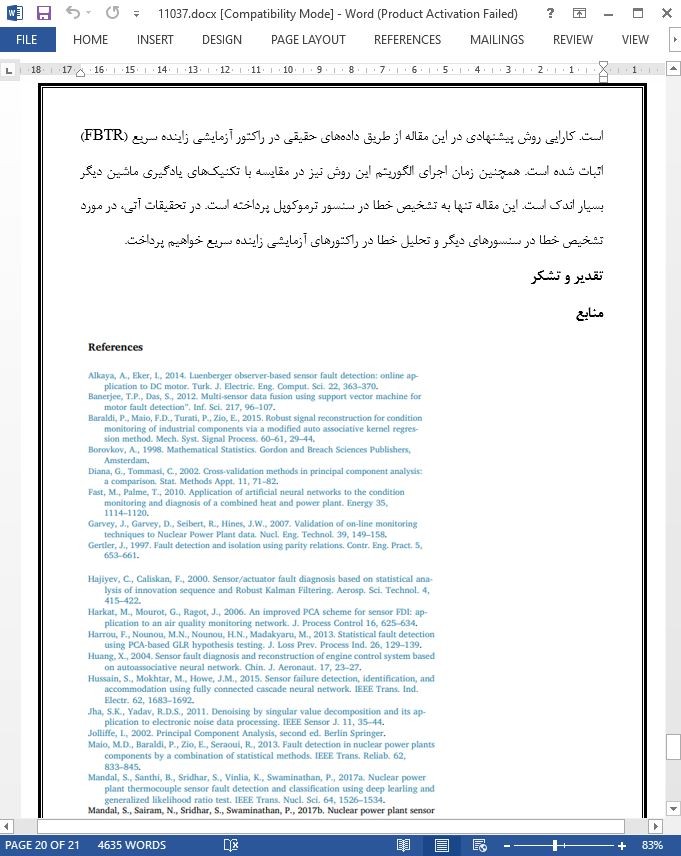
تشخیص خطای سنسور در نیروگاه هسته ای با استفاده از روش های آماری
چکیده
در مقاله پیشرو، یکی از تکنیکهای تشخیص خطا در سنسور و مجزاسازی آن بر اساس روشهای آماری پیشنهاد داده میشود. در این تکنیک، یک روش بازسازی دیتای پیشرفته پیشنهاد شده که مبتنی بر تجزیه مقادیر منفرد (SVD) است. در روش بازسازی SVD سنتی، دادههای خطا میتواند روی دادههای بدون خطا تاثیر بگذارد. اما روش بازسازی SVD پیشرفته (ESVD ) روشی قابل اطمینان برای تصمیمگیری در مورد دادههای خطا مشابه با دادههای طبیعی است. در این مقاله، یک آزمون فرضیهآزمایی موسوم به آزمون نسبت درستنمایی تعمیمیافته (GLRT) برای تشخیص خطا در فضایمازاد مورد استفاده واقع شده است. کارایی روش پیشنهادی، با استفاده از دادههای حقیقی یک راکتور هستهای آزمایشی از نوع زاینده سریع (FBTR) به اثبات رسیده است.
1. مقدمه
پایش پیوسته عملکرد سنسور مزایای بسیاری دارد مثل افزایش اطمینانپذیری، افزایش ایمنی، کاهش آزمایشات غیرضروری کالیبراسیون (واسنجی) دورهای. برای پایش و کنترل یک سیستم تولید پیچیده، تعداد زیادی سنسور استفاده میشود تا اطلاعات دورهای و فضایی مورد نیاز تامین شود. هرچند، با وجود مزایای استفاده از سنسورهای توزیعی، خطراتی نیز وجود دارد زیرا در صورتی که سیگنالهای ارسالی از سنسورها کالیبره نباشد، میتواند عواقب خطرناکی درپیداشته باشد. یک سنسور معیوب (خطادار) اطلاعات نادرستی فراهم مینماید که میتواند بر پایش سیستم و تصمیمگیریهای مربوطه تاثیرگذار باشد. بنابرین، پایش پیوسته عملکرد سنسور یعنی خطایابی و محلیابی خطا موضوعات مهمی هستند که در تحقیق پیش رو به آن پرداخته شده است.
5. نتیجهگیری
پایش آنلاین وضعیت فیزیکی سنسور میتواند از بسیاری از مشکلات مرتبط با کالیبراسیون دستی سنسورها پیشگیری نماید. برای تشخیص خطای سنسور در نیروگاههای هستهای، میتوان از مدل مبتنی بر تجزیه مقدارهای منفرد (SVD) استفاده نمود. این مقاله یک روش پیشرفته بازسازی دیتا مبتنی بر تجزیه مقدارهای منفرد را پیشنهاد مینماید که موسوم به ESVD است و بر روش تجزیه مقدارهای منفرد معمولی (SVD) ارجحیت دارد. این روش، یک روش فاکتورگیری جبر خطی ساده است. روش تجزیه مقدارهای منفرد پیشرفته (ESVD) برای تولید ماتریس مازاد استفاده میشود. این کار از طریق انتخاب تعداد اندکی از بردارهای منفرد متناظر با بزرگترین مقادیر منفرد انجام میشود. بدین وسیله ماتریس بازسازی با دادههای نرمال انطباق داده میشود. در فضای مازاد از آزمون نسبت درستنمايي تعميميافته (GLRT) برای تشخیص خطا در سنسور استفاده میشود. اگر تابع تصمیمگیری GLRT از مقدار آستانه عبور کند آنگاه خطا شناسایی میشود.
Abstract
In this paper, a sensor fault detection and isolation technique is proposed using statistical methods. An enhanced reconstruction method is proposed using Singular Value Decomposition (SVD). In the traditional SVD reconstruction method, the faulty data may affect other fault free data. The enhanced SVD (ESVD) reconstruction method is a robust method to map as a normal data. The statistical hypothesis test, namely Generalized Likelihood Ratio Test (GLRT) is applied to detect the fault in the residual space. The proposed method performance is verified by the real data of Fast Breeder Test Reactor (FBTR).
1. Introduction
Continuous sensor health condition monitoring provides a variety of benefits such as improved reliability, improved safety, reduced unnecessary periodical sensor calibration testing. For monitoring and controlling application of a complex production system, a large number of distributed sensors are used to provide chronological and spatial information. However, along with the benefit of using distributed sensors, there are some risks because of the severe consequences may arise, if the signals provided by sensors are out of calibration. A faulty sensor can provide an inappropriate information that can affect the system supervision and decisions making. Therefore, continuous monitoring of the performance of the sensor, i.e., sensor fault detection and localization are important issues in current research work.
5. Conclusions
Online monitoring of the sensor physical condition can avoid many problems associated with manual calibration of the sensors. The SVD based model is developed for detection the sensor fault in Nuclear Power Plants. This paper addresses an enhanced SVD (ESVD) reconstruction method, which is superior to SVD reconstruction. It is a simple linear algebraic factorization method. The ESVD is used to generate the residual matrix by selecting few singular vectors corresponding to largest singular values. The reconstruction matrix is mapped to the normal data. The GLRT is employed in residual space to detect the faulty sensor. If the GLRT decision function crosses the threshold value, then the fault is detected. The ESVD-GLRT based fault detection method is better than PCA-GLRT and SVD-GLRT
چکیده
1. مقدمه
2. شرح مختصری در مورد راکتور آزمایشی زاینده سریع (FBRT)
3. روش پیشنهادی
3.1. بازسازی دادهها با استفاده از روش تحلیل مولفههای اصلی (PCA)
3.2. روش تجزیه مقدارهای منفرد سنتی برای بازسازی دادهها
3.3. روش SVD پیشرفته برای بازسازی دادهها
3.4. آزمون نسبت درستنمایی تعمیمیافته
۴. نتایج و بحث
5. نتیجهگیری
ABSTRACT
1. Introduction
2. Brief description of FBTR
3. Proposed method
3.1. Data reconstruction using PCA
3.2. Traditional singular value decomposition for data reconstruction
3.3. Enhanced SVD method for data reconstruction
3.4. Generalized likelihood ratio test
4. Result and discussion
5. Conclusions
- ترجمه فارسی مقاله با فرمت ورد (word) با قابلیت ویرایش، بدون آرم سایت ای ترجمه
- ترجمه فارسی مقاله با فرمت pdf، بدون آرم سایت ای ترجمه



